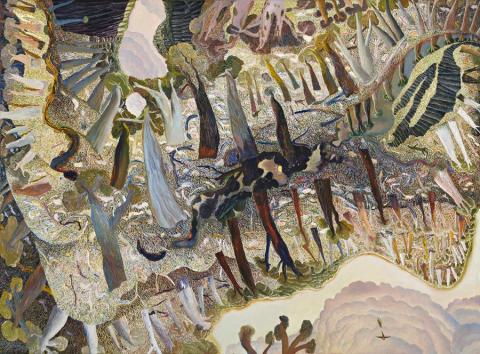SUMMER NOON, c.1988
WILLIAM ROBINSON
oil on canvas
143.0 x 194.0 cm
signed lower left: William Robinson
The First National Bank of Chicago Art Program,
United States of America (label attached verso)
Corporate Collection, Sydney
Sotheby's, Melbourne, 29 November 2004, lot 13
Private collection, Queensland
Uniting a sense of the picturesque with the romantic expression of nature's timelessness, immensity and calm beauty, Summer Noon is an outstanding example of the highly original landscapes for which Robinson has become so widely admired and acclaimed. Inspired by
the luxuriant rainforest of the Canugra-Beechmont area in south-east Queensland where the artist settled with his family in 1984, the work encapsulates an intermediate vision between his more straightforward, naturalistic farmyard scenes executed at Birkdale during the 1980s - whimsical images full of wit and incident - and his dramatic transcendental earthscapes of the 1990s which accent the majestic, mysterious power of nature.
Sublimely exotic, spectacularly dramatic and potentially hazardous, Beechmont was certainly a stark contrast to the artist's relatively benign surroundings at Birkdale. Revealing constantly changing states according to the vagaries of the weather, indeed Robinson found this landscape impossible to observe from a conventional viewpoint - endless acres of rainforest towered above or disappeared below, offering occasional, surreal glimpses of sky, as featured here in the radiating shafts of sunlight reflected in the forest pool. Accordingly, where previously the Australian landscape tradition had been characterised by a strong horizontality, Robinson now deliberately eschewed established figure-ground relationships and one-point perspective to transform the landscape into a multi-view experience - allowing every fold and fissure to be explored, yet still preserving a sense of panoramic continuity.
While quintessentially Australian - parrots soar, a large goanna basks in the heat, and wallabies race between the trees - Summer Noon simultaneously belongs to another time and place, ancient and immutable. Such sense of universality is heightened by the noticeable lack of human presence here vis a vis his earlier renditions such as Beechmont with Starry Night (lot 8) where figures of the artist and his wife Shirley gaze in wonderment at the beauty of their newfound Eden. Thus abandoning narrative for more universal and metaphysical concerns, in the present work Robinson immortalises the power of this silent, eternal landscape by conveying not simply that which he observes, but also what he perceives within himself in his quest for meaning and a spiritual connectedness with the land. Like Wordsworth's emotion recollected in tranquillity, for Robinson the process of painting is about 'contemplating things felt or remembered'. As Hannah Fink suggests, 'wholeness resides in the experience of the landscape itself - as such, his paintings may be considered both compelling approximations of, and poetic tributes to, that sacred moment in which the physical and spiritual become synonymous.'1
1. Fink, H., 'Light Years: William Robinson and the Creation Story' in Seear, L., (ed.) Darkness and Light, Queensland Art Gallery, 2001, p. 29
VERONICA ANGELATOS
